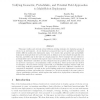Free Online Productivity Tools
i2Speak
i2Symbol
i2OCR
iTex2Img
iWeb2Print
iWeb2Shot
i2Type
iPdf2Split
iPdf2Merge
i2Bopomofo
i2Arabic
i2Style
i2Image
i2PDF
iLatex2Rtf
Sci2ools
IJRR
2011
2011
Unifying geometric, probabilistic, and potential field approaches to multi-robot deployment
This paper unifies and extends several different existing strategies for deploying groups of robots in an environment. A cost function is proposed that can be specialized to represent widely different multi-robot deployment tasks. It is shown that geometric and probabilistic deployment strategies that were previously seen as distinct are in fact related through this cost function, and differ only in the value of a single parameter. These strategies are also related to potential field based controllers through the same cost function, though the relationship is not as simple. Distributed controllers are then obtained from the gradient of the cost function and are proved to converge to a local minimum of the cost function. Three special cases are derived as examples: a Voronoi based coverage control task, a probabilistic minimum variance task, and a task using artificial potential fields. The performance of the three different controllers are compared in simulation. A result is a...
| Added | 14 May 2011 |
| Updated | 14 May 2011 |
| Type | Journal |
| Year | 2011 |
| Where | IJRR |
| Authors | Mac Schwager, Daniela Rus, Jean-Jacques E. Slotine |
Comments (0)

